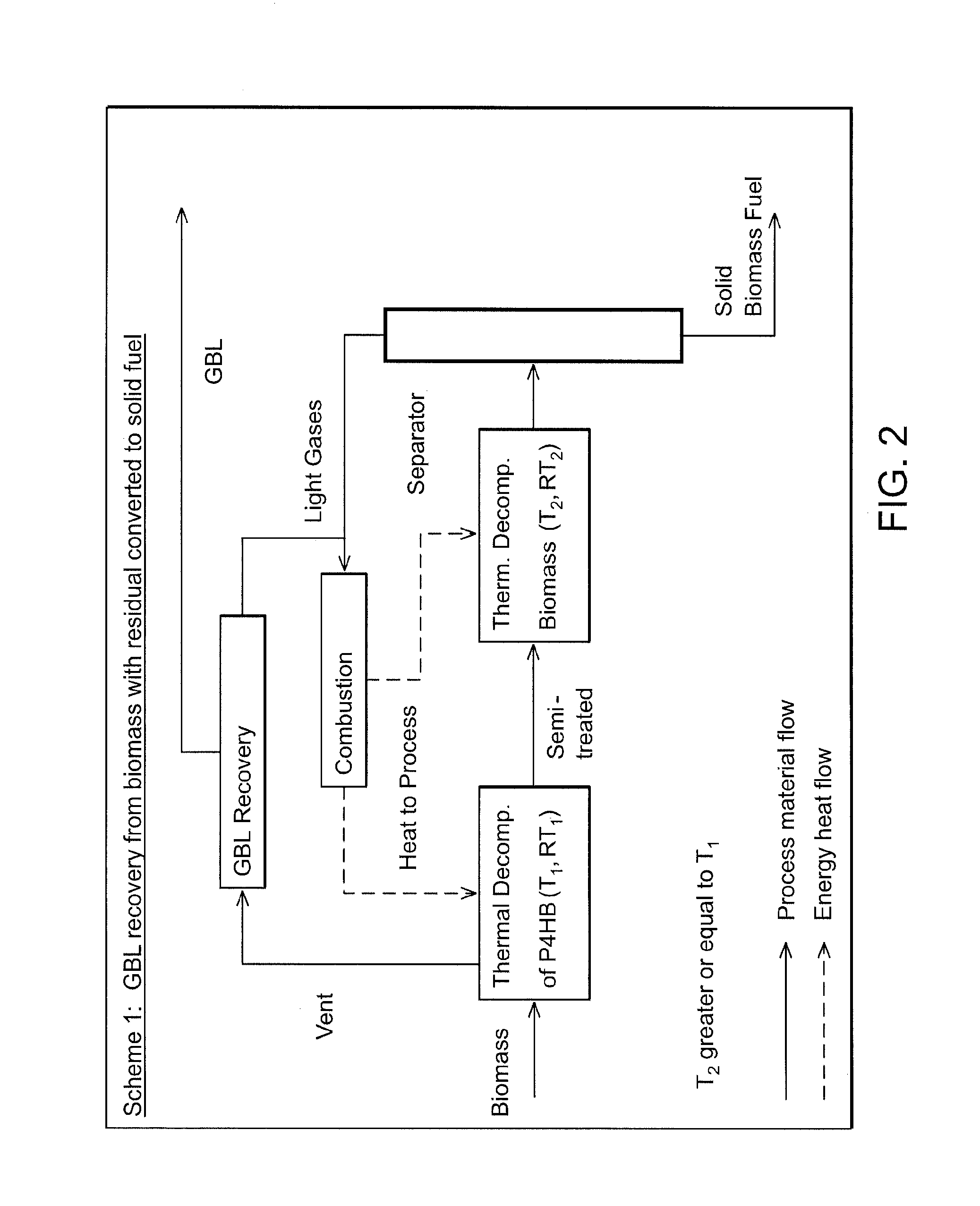Biorefinery Process For THF Production
a biorefinery and process technology, applied in the field of thf production, can solve the problems of not very environmentally friendly processes, high flammability and explosive feedstock, etc., and achieve the effect of improving the energetics of the process and eliminating costly and energy-intensive unit operations
- Summary
- Abstract
- Description
- Claims
- Application Information
AI Technical Summary
Benefits of technology
Problems solved by technology
Method used
Image
Examples
example 1
4HB Polymer Production before Modification
[0102]This example shows the 411B polymer production capability of microbial strains have not been optimized to incorporate high mole % 4HB from renewable carbon resources. The strains used in this example are listed in Table 2. Strains 1 and 2 were described by Dennis and Valentin (U.S. Pat. No. 6,117,658).
TABLE 2Strains used in Example 1Relevant host genomeStrainsmodificationsGenes overexpressed1Ptac-phaCABPlac-orfZ-′cat1-sucD-4hbD2yneI-negativePtac-phaCABPlac-orfZ-′cat1-sucD-4hbD3ΔyneI ΔgabDPX-phaC, P12-phaABPlac-orfZ-′cat1-sucD-4hbD
[0103]Strain 3 contained deletions of both the yneI and gabD chromosomal genes (FIG. 1 and Table 1A, Reaction Number 12) which encode the CoA-independent, NAD-dependent succinate semialdehyde (SSA) dehydrogenase and the CoA-independent, NADP-dependent SSA dehydrogenase, respectively. To accomplish this, a derivative strain of LS5218 (Jenkins and Nunn J. Bacteriol. 169:42-52 (1987)) was used that expressed phaA...
example 2
P4HB Production Via an α-Ketoglutarate Decarboxylase or a Succinyl-CoA Dehydrogenase
[0106]Several metabolic pathways were proposed to generate succinic semialdehyde (SSA) from the tricarboxylic acid (TCA) cycle (reviewed by Steinbuchel and Lütke-Eversloh, Biochem. Engineering J. 16:81-96 (2003) and Efe et al., Biotechnology and Bioengineering 99:1392-1406 (2008). One pathway converts succinyl-CoA to SSA via a succinyl-CoA dehydrogenase, which is encoded by sucD (Söhling and Gottschalk, J. Bacterial. 178:871-880 (1996); FIG. 1, Reaction number 7). A second pathway converts alpha-ketoglutarate to SSA via an alpha-ketoglutarate decarboxylase that is encoded by kgdM (Tian et al. Proc. Natl. Acad. Sci. U.S.A. 102:10670-10675 (2005); FIG. 1, Reaction number 8). A third pathway converts alpha-ketoglutarate to SSA via L-glutamate and 4-aminobutyrate using a glutamate dehydrogenase (EC 1.4.1.4), a glutamate decarboxylase (EC 4.1.1.15), and a 4-aminobutyrate transaminase (EC 2.6.1.19), or a 4...
example 3
Improvement in P(4HB) Production by Overexpressing Certain Succinic Semialdehyde Reductase Genes
Effect of 4hbD on P4HB Production
[0110]The succinic semialdehyde (SSA) reductase gene 4hbD was used by Dennis and Valentin (U.S. Pat. No. 6,117,658) to produce P3HB-co-4HB copolymer. To see how effective overproduction of this SSA reductase was for P4HB homopolymer production, the 4hbD gene was overexpressed by the IPTG-inducible Ptrc promoter (strain 8). An empty vector containing strain served as a control (strain 7). The host strain used contained chromosomal deletions of genes yneI and gabD and also overexpressed the recombinant genes orfZ, sucD* and phaC3 / C1* as shown in Table 6.
TABLE 6Microbial Strains used in this section of Example 3Relevant hostgenomeStrainsmodificationsGenes overexpressed7ΔyneI ΔgabDPrpsU-orfZ, PuspA-phaC3 / C1*-sucD*8ΔyneI ΔgabDPrpsU-orfZ, PuspA-phaC3 / C1*-sucD*,Ptrc-4hbD
[0111]The strains were grown in a 48 hour shake plate assay. The production medium consisted o...
PUM
| Property | Measurement | Unit |
|---|---|---|
| temperature | aaaaa | aaaaa |
| temperature | aaaaa | aaaaa |
| temperature | aaaaa | aaaaa |
Abstract
Description
Claims
Application Information
 Login to View More
Login to View More - R&D
- Intellectual Property
- Life Sciences
- Materials
- Tech Scout
- Unparalleled Data Quality
- Higher Quality Content
- 60% Fewer Hallucinations
Browse by: Latest US Patents, China's latest patents, Technical Efficacy Thesaurus, Application Domain, Technology Topic, Popular Technical Reports.
© 2025 PatSnap. All rights reserved.Legal|Privacy policy|Modern Slavery Act Transparency Statement|Sitemap|About US| Contact US: help@patsnap.com



